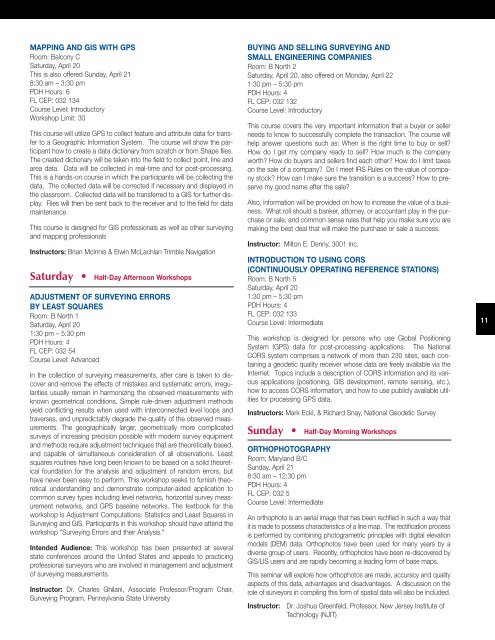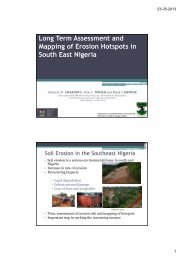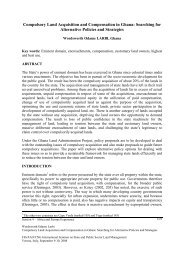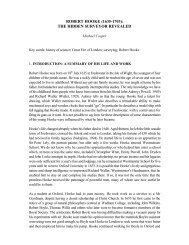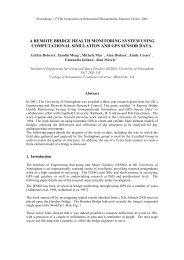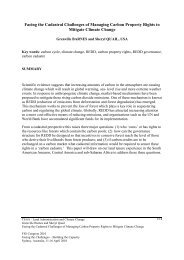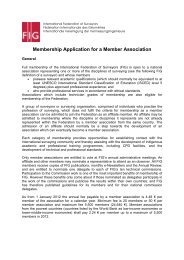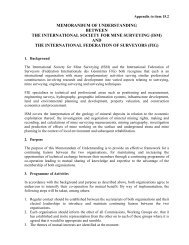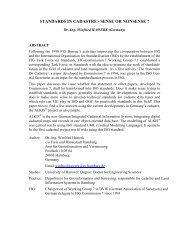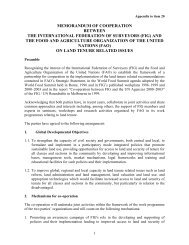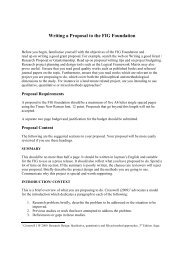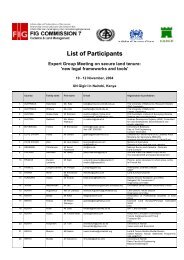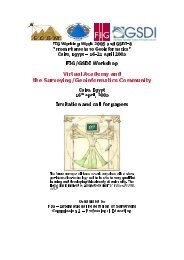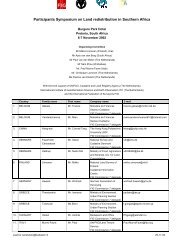You also want an ePaper? Increase the reach of your titles
YUMPU automatically turns print PDFs into web optimized ePapers that Google loves.
MAPPING AND GIS WITH GPS<br />
Room: Balcony C<br />
Saturday, April 20<br />
This is also offered Sunday, April 21<br />
8:30 am – 3:30 pm<br />
PDH Hours: 6<br />
FL CEP: 032 134<br />
Course Level: Introductory<br />
Workshop Limit: 30<br />
This course will utilize GPS to collect feature and attribute data for transfer<br />
to a Geographic Information System. The course will show the participant<br />
how to create a data dictionary from scratch or from Shape files.<br />
The created dictionary will be taken into the field to collect point, line and<br />
area data. Data will be collected in real-time and for post-processing.<br />
This is a hands-on course in which the participants will be collecting the<br />
data. The collected data will be corrected if necessary and displayed in<br />
the classroom. Collected data will be transferred to a GIS for further display.<br />
Files will then be sent back to the receiver and to the field for data<br />
maintenance.<br />
This course is designed for GIS professionals as well as other surveying<br />
and mapping professionals<br />
Instructors: Brian McInnis & Elwin McLachlan Trimble Navigation<br />
Saturday • Half-Day Afternoon Workshops<br />
ADJUSTMENT OF SURVEYING ERRORS<br />
BY LEAST SQUARES<br />
Room: B North 1<br />
Saturday, April 20<br />
1:30 pm – 5:30 pm<br />
PDH Hours: 4<br />
FL CEP: 032 54<br />
Course Level: Advanced<br />
In the collection of surveying measurements, after care is taken to discover<br />
and remove the effects of mistakes and systematic errors, irregularities<br />
usually remain in harmonizing the observed measurements with<br />
known geometrical conditions. Simple rule-driven adjustment methods<br />
yield conflicting results when used with interconnected level loops and<br />
traverses, and unpredictably degrade the quality of the observed measurements.<br />
The geographically larger, geometrically more complicated<br />
surveys of increasing precision possible with modern survey equipment<br />
and methods require adjustment techniques that are theoretically based,<br />
and capable of simultaneous consideration of all observations. Least<br />
squares routines have long been known to be based on a solid theoretical<br />
foundation for the analysis and adjustment of random errors, but<br />
have never been easy to perform. This workshop seeks to furnish theoretical<br />
understanding and demonstrate computer-aided application to<br />
common survey types including level networks, horizontal survey measurement<br />
networks, and GPS baseline networks. The textbook for this<br />
workshop is Adjustment Computations: Statistics and Least Squares in<br />
Surveying and GIS. Participants in this workshop should have attend the<br />
workshop "Surveying Errors and their Analysis."<br />
Intended Audience: This workshop has been presented at several<br />
state conferences around the United States and appeals to practicing<br />
professional surveyors who are involved in management and adjustment<br />
of surveying measurements.<br />
Instructor: Dr. Charles Ghilani, Associate Professor/Program Chair,<br />
Surveying Program, Pennsylvania State University<br />
BUYING AND SELLING SURVEYING AND<br />
SMALL ENGINEERING COMPANIES<br />
Room: B North 2<br />
Saturday, April 20, also offered on Monday, April 22<br />
1:30 pm – 5:30 pm<br />
PDH Hours: 4<br />
FL CEP: 032 132<br />
Course Level: Introductory<br />
This course covers the very important information that a buyer or seller<br />
needs to know to successfully complete the transaction. The course will<br />
help answer questions such as: When is the right time to buy or sell?<br />
How do I get my company ready to sell? How much is the company<br />
worth? How do buyers and sellers find each other? How do I limit taxes<br />
on the sale of a company? Do I meet IRS Rules on the value of company<br />
stock? How can I make sure the transition is a success? How to preserve<br />
my good name after the sale?<br />
Also, information will be provided on how to increase the value of a business.<br />
What roll should a banker, attorney, or accountant play in the purchase<br />
or sale, and common sense rules that help you make sure you are<br />
making the best deal that will make the purchase or sale a success.<br />
Instructor: Milton E. Denny, 3001 Inc.<br />
INTRODUCTION TO USING CORS<br />
(CONTINUOUSLY OPERATING REFERENCE STATIONS)<br />
Room: B North 5<br />
Saturday, April 20<br />
1:30 pm – 5:30 pm<br />
PDH Hours: 4<br />
FL CEP: 032 133<br />
Course Level: Intermediate<br />
This workshop is designed for persons who use Global Positioning<br />
System (GPS) data for post-processing applications. The National<br />
CORS system comprises a network of more than 230 sites, each containing<br />
a geodetic quality receiver whose data are freely available via the<br />
Internet. Topics include a description of CORS information and its various<br />
applications (positioning, GIS development, remote sensing, etc.),<br />
how to access CORS information, and how to use publicly available utilities<br />
for processing GPS data.<br />
Instructors: Mark Eckl, & Richard Snay, National Geodetic Survey<br />
Sunday • Half-Day Morning Workshops<br />
ORTHOPHOTOGRAPHY<br />
Room: Maryland B/C<br />
Sunday, April 21<br />
8:30 am – 12:30 pm<br />
PDH Hours: 4<br />
FL CEP: 032 5<br />
Course Level: Intermediate<br />
An orthophoto is an aerial image that has been rectified in such a way that<br />
it is made to possess characteristics of a line map. The rectification process<br />
is performed by combining photogrametric principles with digital elevation<br />
models (DEM) data. Orthophotos have been used for many years by a<br />
diverse group of users. Recently, orthophotos have been re-discovered by<br />
GIS/LIS users and are rapidly becoming a leading form of base maps.<br />
This seminar will explore how orthophotos are made, accuracy and quality<br />
aspects of this data, advantages and disadvantages. A discussion on the<br />
role of surveyors in compiling this form of spatial data will also be included.<br />
Instructor: Dr. Joshua Greenfeld, Professor, New Jersey Institute of<br />
Technology (NJIT)<br />
11


